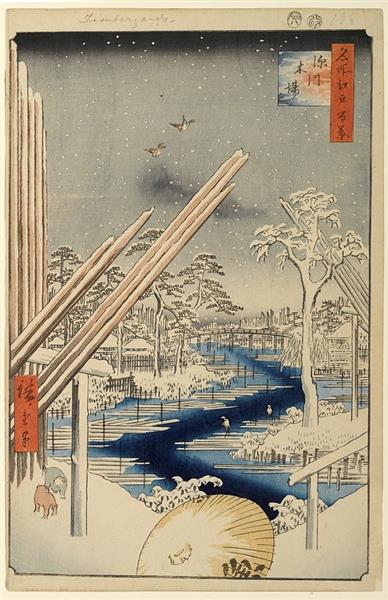描述
The painting "The Sawmills of Fukagawa" from 1857, by Utagawa Hiroshige, is one of the most representative works of the series "Fifty-three Stations of the Tōkaidō Road". Hiroshige, a master of ukiyo-e, is known for his ability to capture not only the beauty of Japanese landscapes, but also the daily life of his time.
In “Fukagawa’s Sawmills,” the composition is illuminated by a careful arrangement of elements that directs the viewer’s gaze across the scene. The painting depicts vibrant activity at the sawmill, with human figures that, though small in comparison to the majesty of the surroundings, provide a palpable dynamic. Immersed in work tasks such as log handling and lumber manufacturing, these characters add a dimension of life and movement to the work. Their human presence suggests a sense of community and collective effort, presenting a world in which nature and man coexist in a relationship of mutual dependence.
The dominant colours in the painting include warm shades of brown and green, evoking the richness of forests and wood, as well as subtle blues that suggest sky and water. Hiroshige is well known for his use of colour to create atmosphere and evoke emotion; in this piece, the palette is masterfully used to capture the industrial essence of the sawmill. The technique of shadow and light allows the logs, tools and paths to come to life, imbuing the scene with a sense of depth and volume.
The central composition of stacked logs and sawmill highlights not only productive activity, but also a sense of transformation – from the natural to the industrial. This is a recurring theme in Hiroshige’s work, where interactions between nature and human activity are at the heart of his artistic exploration. Through his work, Hiroshige documents not only a place, but also a moment in Japanese history – a period when industrialisation was beginning to leave its mark on the traditional landscape.
As part of the ukiyo-e school, Hiroshige was distinguished by his skill in using woodblock printing, a technique that allowed for detailed and vivid depiction of life and landscapes in the Edo period. Looking at similar works by Hiroshige, one can trace an arc that links both the everyday and the sublime, with each scene inviting deeper reflection on the relationship between humans and their environment. Paintings such as Mount Fuji from the Tōkaidō Road or A Night in the Rain in Kyoto exemplify the same attention and care for nature and everyday life.
“Fukagawa Sawmills” is not only a visual representation of life in a sawmill, but also offers us a glimpse into mid-19th century Japan, capturing a time of transformation and industrialization. Through this work, Hiroshige strikes a balance between aesthetic beauty and everyday reality, a distinctive trait that continues to resonate in contemporary visual culture. Ultimately, this painting is a testament to Hiroshige’s ability to fuse nature with humanity, creating a visual dialogue that remains relevant to this day.
KUADROS ©, a famous painting on your wall.
Hand-made oil painting reproductions, with the quality of professional artists and the distinctive seal of KUADROS ©.
Painting reproduction service with satisfaction guarantee. If you are not completely satisfied with the replica of your painting, we will refund 100% of your money.

